These teeth tell us the allosaurs were there, and that there might have even been a few different undiscovered species of them in this mysterious time and place which is still being discovered and explored!
~130 million years ago in the Early Cretaceous Period in what is now southeastern Utah, a large theropod dinosaur came to a seasonal stream bed to feed on a dead sauropod. We don’t know if the theropod killed the sauropod or if the sauropod was already dead and the theropod scavenged it. But what we do know is that this in the process of feeding, it shed several teeth. This is not a special occurrence in and of itself. Shedding teeth is common for theropods, for like crocodilians, they replace their teeth regularly. What makes these teeth special is the kind of theropod that shed them. This theropod is a type of allosaur, possibly an early carcharodontosaur (a subtype of allosaur), likely a cousin of the European Neovenator and of the slightly later American Acrocanthosaurus. Curiously, known fossil remains of allosaurs from this time and region are thus far almost completely absent. The teeth shed from that ancient meal constitute some of the only evidence that these majestic meat-eaters existed.
This ancient scene, or what’s left of it, was preserved in the rocks of the Yellow Cat Member of the Cedar Mountain Formation. The Cedar Mountain Formation is divided into several subunits called members. In order from oldest to youngest the most major and fossiliferous are the Yellow Cat (~140-125 million years old, depending on who you ask), the Ruby Ranch (~114 million years ago), and the Mussentuchit (~104-98 million years ago) Members. The Mussentuchit Member contains evidence for a large theropod called Siats, though paleontologists disagree as to what Siats is, with some considering it a neovenatorid allosaur within Carcharodontosauria and others considering it a megaraptoran within Tyrannosauroidea. The Ruby Ranch bears some evidence of a carcharodontosaurian allosaur similar to Acrocanthosaurus, a theropod which is known from the eastern and central United States during roughly the same time. The Ruby Ranch theropod is known from teeth reported by Utah paleontologist Jim Kirkland as well as footprints at the Mill Canyon Dinosaur Track Site near Moab, Utah.
And then there’s the Yellow Cat Member, which, until recently, has yielded almost no evidence of allosaurs at all, despite allosaurs being the dominant large predatory dinosaurs across most land masses from the Late Jurassic through the early Late Cretaceous. Kirkland reported on a few allosaur teeth from the lower portion of the Yellow Cat in the early 2000s, but no more allosaur material has been found/described, and evidence of allosaurs has been completely absent from the upper portion of the Yellow Cat. This has led some to believe that, for whatever reason, allosaurs were absent from the upper Yellow Cat paleoenvironment. Some have assumed that the apex predator of this environment must have been the large dromaeosaur Utahraptor, discovered by Brigham Young University’s Jim Jensen in 1975 and named by Jim Kirkland in 1993. This interpretation or assumption has even found its way into some media, specifically the 2025 revival of BBC’s Walking With Dinosaurs, which portrays Utahraptor as the top predator in an environment free of larger theropods.
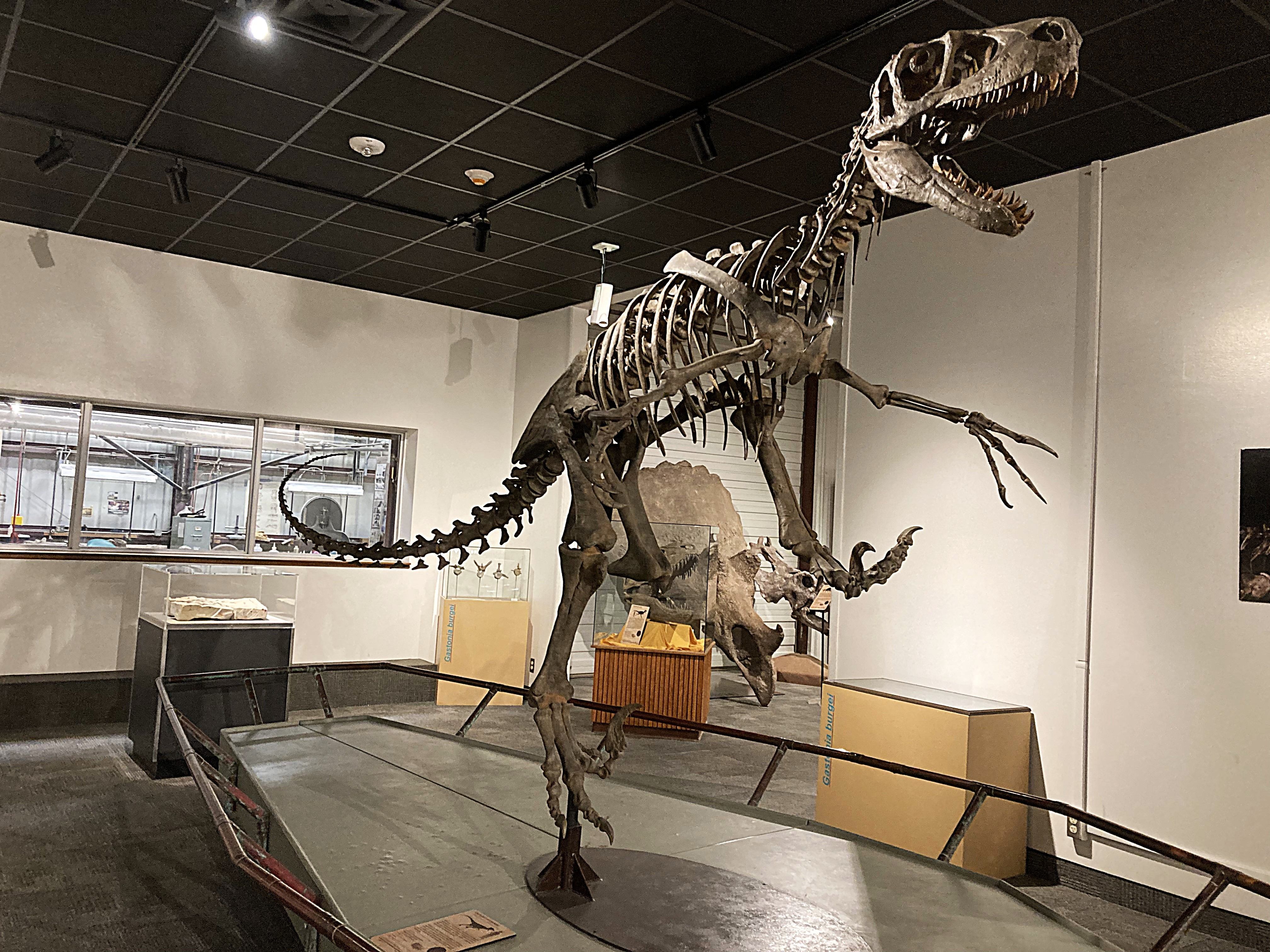
However, this assumption was shattered by a group of researchers, Taylor Oswald, Colin Boisvert, Domenic D’Amore, and Brian Curtice in June of 2025 when they published a scientific paper describing several demonstrably allosaur teeth from the upper portion of the Yellow Cat Member.
These teeth, from a site called “Grayash” near Arches National Park, were discovered and collected in 2022 by a team of paleontologists from Brigham Young University, a team which included both Oswald and Boisvert. A single tooth had been discovered at the site the year before, which intrigued Oswald, who helped lead the charge to excavate the site along with BYU Museum of Paleontology Curator Rod Scheetz.
The actual bones of the Grayash Quarry were scrappy, mostly extremely fragmentary bones of a sauropod, possibly Moabosaurus. The sauropod bones also bore significant damage from bone-eating insects. But among the scrap, were found 15 theropod teeth, several of them well-preserved and mostly or entirely complete. While other researchers were interested in the insect trace marks on the sauropod bones, the teeth were more interesting to Oswald, and while it wasn’t the theropod skeleton the BYU team were hoping for, these teeth brought Oswald’s data set from 1 to 16. A great improvement!
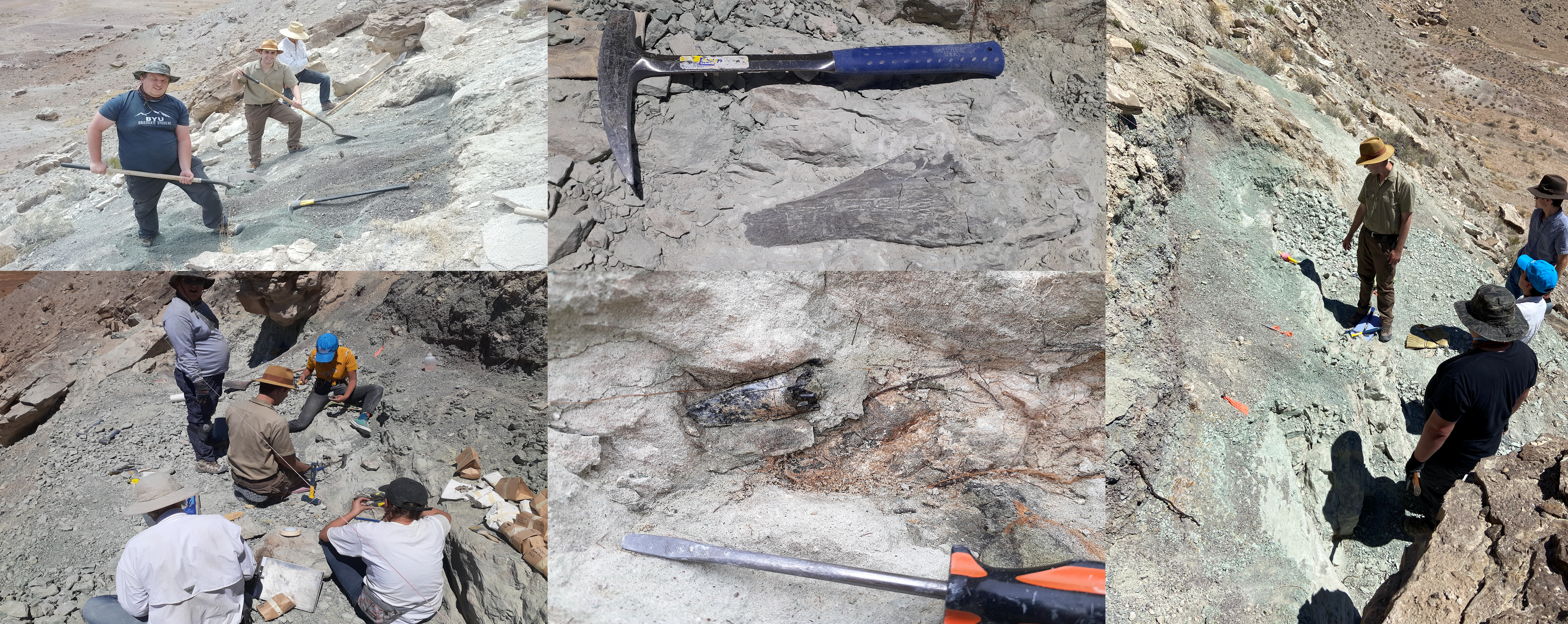
The teeth were carefully prepared by Oswald, and once that was done, the science could begin. Oswald worked with Arizona Museum of Natural History researcher Dr. Brian Curtice to measure dimensions of the teeth and their serration density in order to compare them to the teeth of other theropods.
“We knew they were allosaur teeth from the beginning”, said Oswald. “Early indicators were the shape of some of the teeth which matched the D-shaped profile of allosaur premaxillary teeth, as well as faint enamel wrinkles present on some of the teeth which were similar to enamel wrinkles on the teeth of many allosaurs. But in order to have a paper, we needed to actually demonstrate it quantitatively. Just eyeballing a fossil isn’t always enough.”
As the numbers were crunched, Colin Boisvert was brought onto the project, and after presentation at the 2023 meeting of the Society of Vertebrate Paleontology in Cincinnatti, Ohio, reptile and theropod tooth expert Domenic D’Amore was brought on to lend his expertise and to provide additional analysis of the teeth.
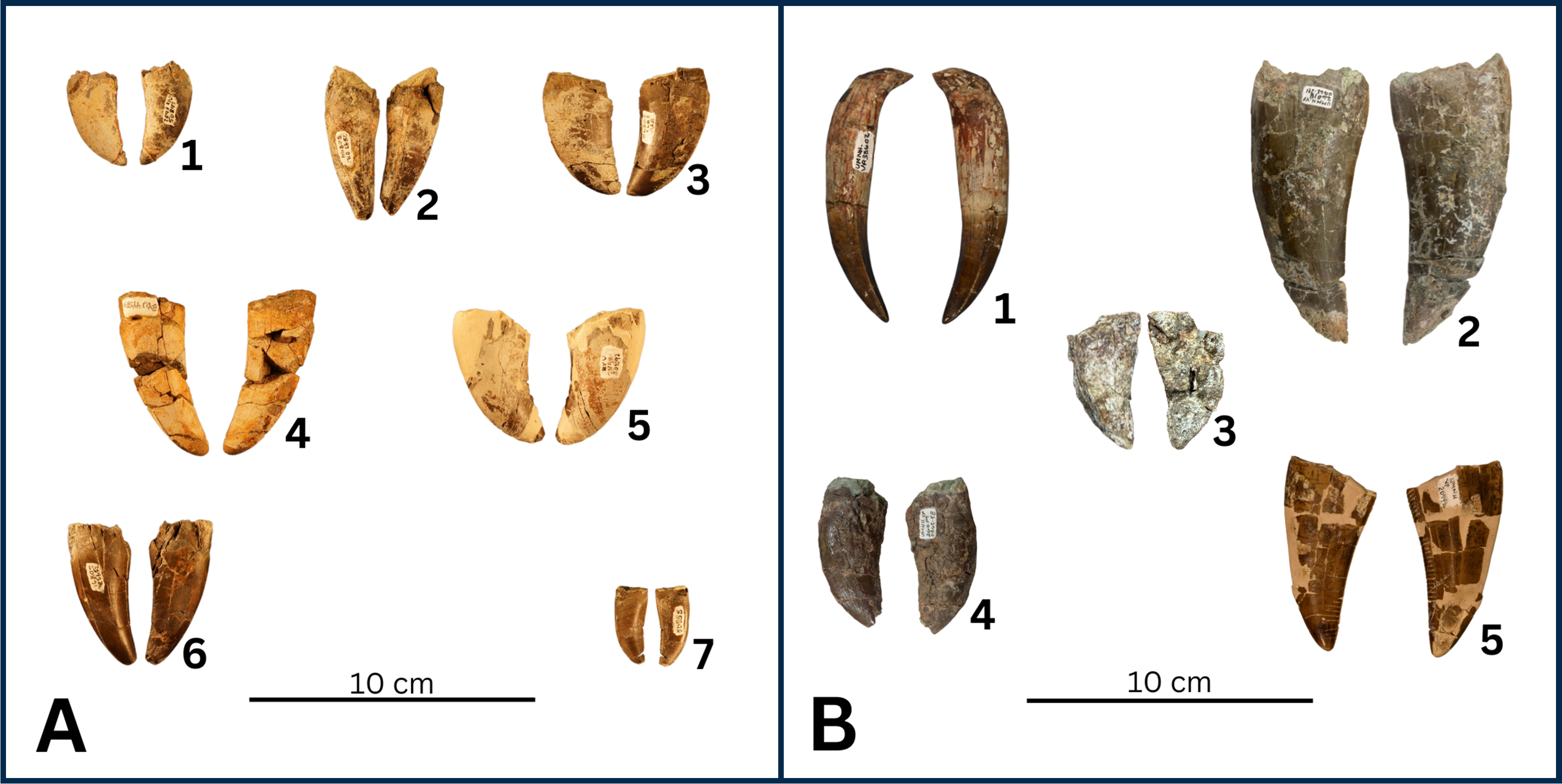
And at last, on June 4th 2025, the paper was published in the Journal of the Arizona Nevada Academy of Science. Not only did the paper demonstrate using quantitative morphological analysis that the Grayash teeth are indeed from an allosaur, but it concluded that the teeth are likely from a type of carcharodontosaur and that they may be different from the lower Yellow Cat teeth reported earlier by Kirkland, as well as another probable allosaur tooth fragment from a different BYU upper Yellow Cat site which also produced a juvenile Utahraptor. The results suggest that there may have been as many as three undiscovered allosaurs in just the Yellow Cat Member!
Analysis of the Ruby Ranch teeth reported previously by Kirkland, which were also included in the study, suggests that these teeth likely do not belong to Acrocanthosaurus and that yet another unnamed allosaur is likely awaiting discovery and description in these rocks. Conversely, a tooth from the Turney Ranch Formation of Arizona, tentatively identified as Acrocanthosaurus by its discoverers, but doubted by Oswald and the team, especially by Curtice, was found to indeed be consistent with Acrocanthosaurus in all the ways it mattered. Thus, as far as they can tell, there really were Acrocanthosaurus in Arizona, or at least something very much like Acrocanthosaurus.
Curtice said of his experience with the Arizona Acro Tooth, “The Arizona Museum of Natural History has a gigantic Acrocanthosaurus literally busting out of the building. It is our recognizable “thing” (all museums strive for at least one), but it was based on a single tooth from the Sonorasaurus locality. One tooth led to the creation of our spectacular display. And N=1 makes me nervioso. When I heard about the project, I asked if we could run the AZ tooth in the analysis. Numbers were crunched....Lo and behold, the AZ tooth falls squarely in the Acro range. The AZ researchers were right, and I was wrong. My (expensive) bet was settled at the bar, and my conscience rests easy knowing I re-searched the tooth and it came up with what the original authors concluded. Trust, but verify!”
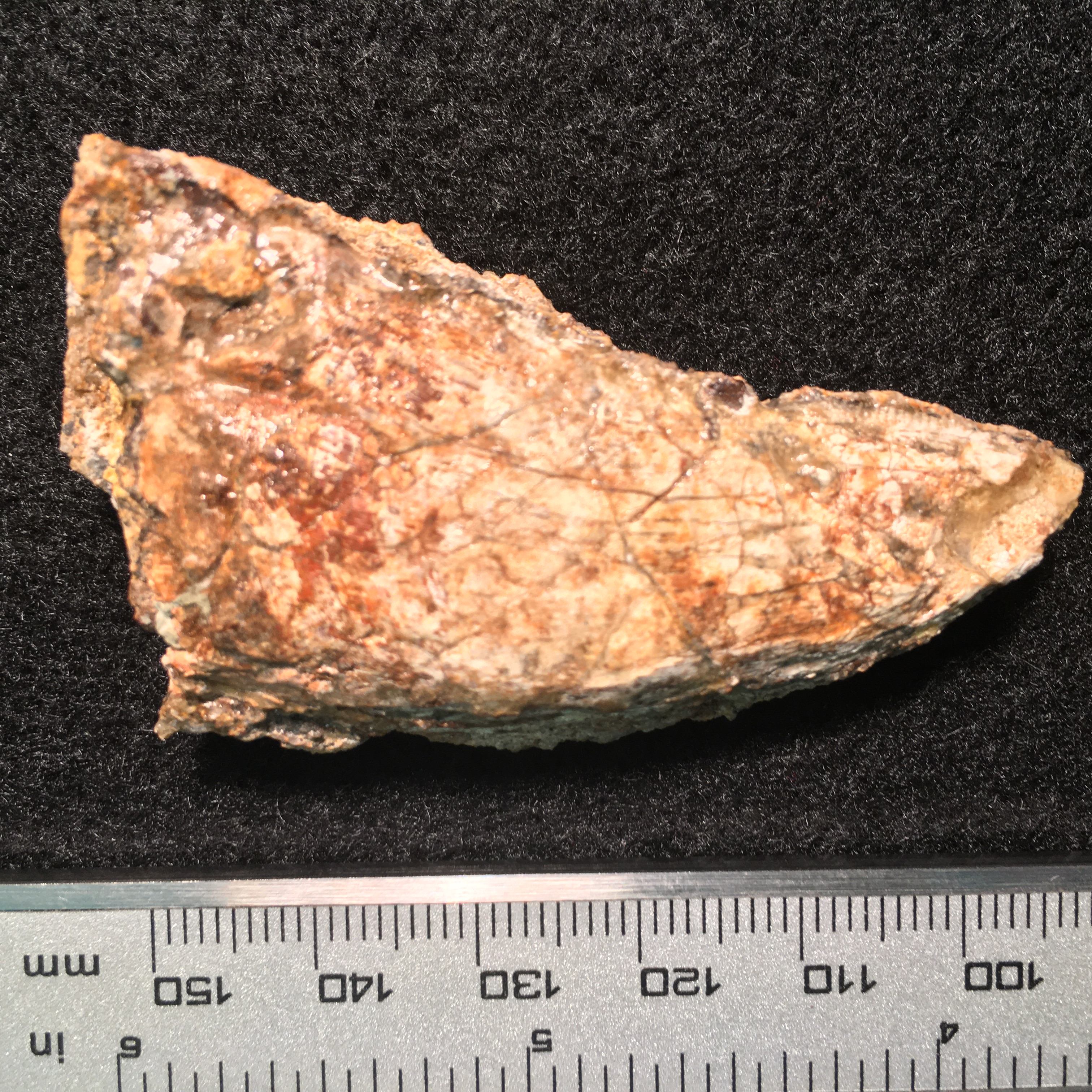
The results of the research help to inform us about the paleoecology of Early Cretaceous North America. Said Oswald, “Not only is it some of the oldest hard evidence for carcharodontosaurs on the continent, but it suggests that there was likely a greater variety of these beasts than previously thought. And perhaps most importantly, it corrects the assumption that Utahraptor had Utah all to itself. It didn’t, and where they crossed paths with our allosaurs, Utahraptor would have been second fiddle.”
Of course, all this begs the question, why has it taken so long to find evidence of allosaurs from the upper Yellow Cat, and why haven’t we found more?
These questions were not answered in the paper, but Oswald has a few thoughts.
“There are a few possibilities that may be in play here. First, maybe the allosaurs are just super rare. That’s a possibility, carnivores are always less common than their prey, and large carnivores are typically less common than small ones. But in other paleoenvironments like the Late Jurassic Morrison Formation or the Late Cretaceous Hell Creek Formation, we still have many good fossils of large predators. They are certainly less common than their prey, but we do still find them. So while I think ecological rarity is a factor, I think it’s not the only reason.
A second possibility is that the allosaurs may have preferred other habitats, maybe upland habitats which don’t preserve fossils as well. Maybe there’s some habitat partitioning between Utahraptor and the allosaurs. Except, our findings show that at least occasionally that wasn’t the case, since we do now have allosaur remains in the same rocks that produce Utahraptor. Plus, we just don’t see that sort of partitioning in other paleoenvironments. Allosaurus coexisted with a few different predators, some smaller, some larger. Carcharodontosaurus is found in the same rocks that produce Spinosaurus. And South American carcharodontosaurs like Giganotosaurus coexisted with abelisaurs like Ekrixinatosaurus. So why would our allosaurs segregate from Utahraptor if that sort of thing just doesn’t seem to happen elsewhere? It doesn’t seem very likely to me. Barring major differences in habitat, a big predator like an allosaur is going to go where the food is, and if that brings it to Utahraptor territory, it’ll just bully the smaller predator if it has to.
The third possibility is that we just haven’t explored the Cedar Mountain Formation as well as we have the Morrison or Hell Creek. The Morrison and Hell Creek Formations and others have been researched for well over a century. Work in the Cedar Mountain Formation has been going on for less than half that, and with a lot fewer collectors and researchers working it. And that is what I think is most likely the key to making sense of this apparent paucity of allosaurs.
A lot of what we know about the Yellow Cat fauna comes from the Dalton Wells Quarry. And it’s a great quarry which preserves a lot of bones from many species. But it still represents more or less a single snapshot of time, and if an allosaur didn’t happen to come along that day, it would be easy for it to be omitted from that temporal snapshot. Because Dalton Wells is so species-rich it’s easy to think, ‘yeah, that’s it, that’s a complete sampling of the Yellow Cat fauna’, but it’s still just a single quarry, a good data point, but still a data point of one. There are other quarries of course, but they aren’t as prolific as Dalton Wells, and there are much fewer of them than, say, the Morrison Formation. Most of what we know about the Yellow Cat still comes from Dalton Wells, but the formation is so much bigger than a single quarry. I think the allosaurs are out there, we just haven’t found them yet. And hopefully that’ll change real soon.”
The authors gave their paper the title: “Here Be Dragons”. Oswald commented on the title, saying: “Here Be Dragons” (Latin: hic sunt dracones), [is] an old phrase used to mark the edge of the map, to denote the unknown, dangerous, mysterious, and unexplored regions of the world…These teeth tell us the allosaurs were there, and that there might have even been a few different undiscovered species of them leaving behind these “dragon” teeth in this mysterious time and place which is still being discovered and explored!”
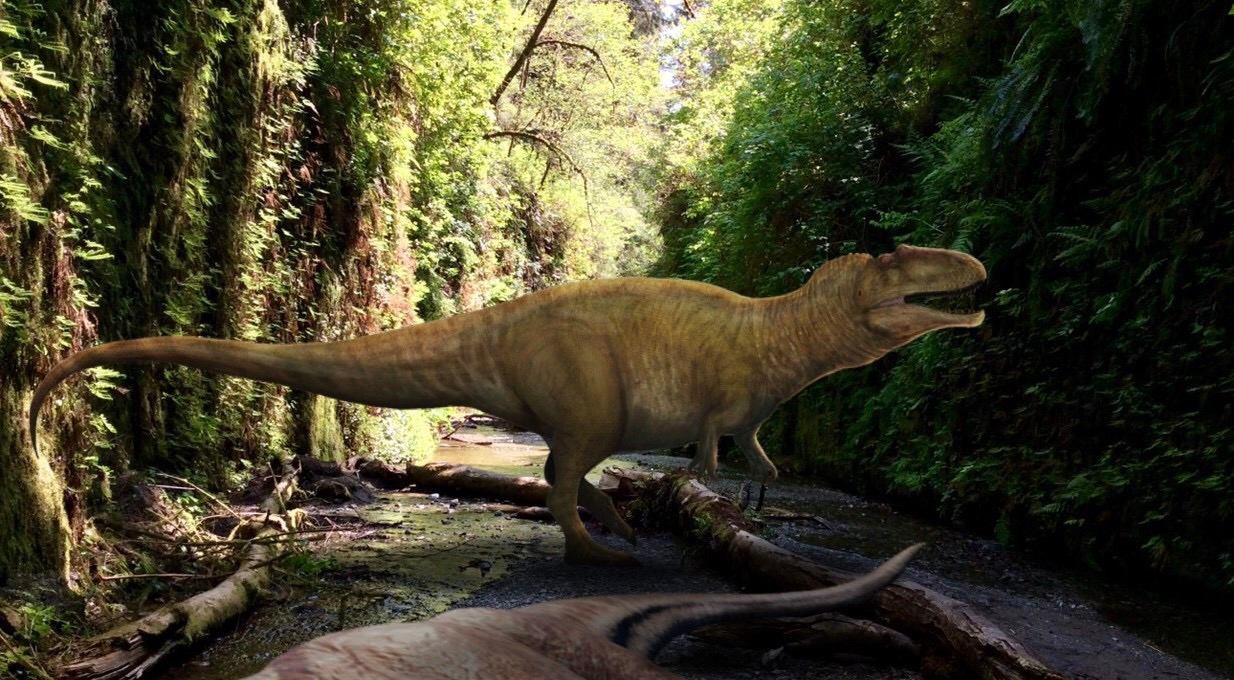
For more information, you can read “Here Be Dragons” by Oswald et al. here:
Taylor Oswald, Colin Boisvert, Domenic D'amore, and Brian Curtice "“Here be Dragons”: Shed Teeth Potentially Indicate the Presence of Multiple Unidentified Allosauroids from the Early Cretaceous Cedar Mountain Formation of Utah," Journal of the Arizona-Nevada Academy of Science 50(2), 55-129, (4 June 2025). https://doi.org/10.2181/036.050.0204